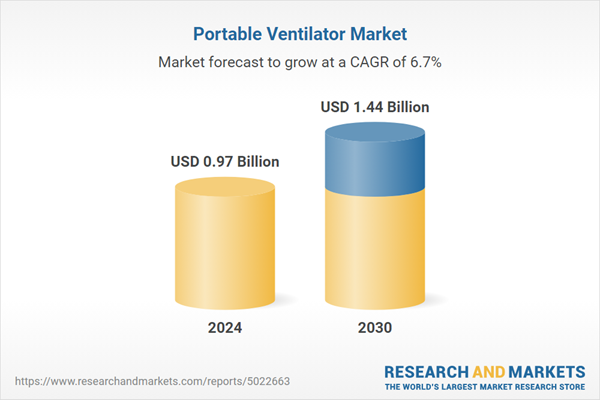Speak directly to the analyst to clarify any post sales queries you may have.
10% Free customizationThis report comes with 10% free customization, enabling you to add data that meets your specific business needs.
It operates by delivering gas to the lungs at normal tidal volumes and breathing rates through an endotracheal tube, cannula, or mask, utilizing positive pressure. These ventilators are also employed for providing various modes of ventilation, such as combined-, pressure-, and volume-mode ventilation, as well as assist-control, synchronized intermittent mandatory, airway pressure release, and pressure support ventilation. Consequently, portable ventilators are extensively employed for long-term respiratory care in homes, hospitals, and ambulatory care centers.
Key Market Drivers
Increasing Prevalence of Chronic Respiratory Diseases
The rising incidence of chronic respiratory diseases worldwide is a significant driver for market growth. Portable ventilators are extensively employed in intensive care units and hospital wards to provide respiratory support for patients with conditions such as asthma, pneumonia, emphysema, and lung cancer. Chronic respiratory diseases, such as chronic obstructive pulmonary disease (COPD), asthma, and interstitial lung disease, often lead to compromised lung function. As the prevalence of these conditions rises, more individuals may require respiratory support to manage their breathing difficulties.Chronic respiratory diseases can have acute exacerbations or flare-ups that significantly worsen breathing problems. Portable ventilators can assist in managing these exacerbations, providing immediate relief and reducing the need for hospitalization. Portable ventilators empower patients to take control of their health by actively participating in their respiratory care. Patients can adjust settings and monitor their condition, leading to better treatment adherence.
Key Market Challenges
Large Population of Undiagnosed & Undertreated Patients
Lack of awareness about portable ventilators and their benefits can lead to delayed diagnosis and treatment for individuals with respiratory conditions. This delay may result in worsened symptoms and poorer outcomes. Portable ventilators can provide early intervention for individuals with respiratory distress, preventing the progression of their conditions to more severe stages. Lack of awareness may mean missed opportunities for timely treatment. Undiagnosed and undertreated patients may seek care in healthcare facilities only when their conditions worsen, leading to increased strain on hospitals and clinics. Late diagnosis and inappropriate treatment can result in higher healthcare costs due to increased hospitalizations, emergency room visits, and the need for more intensive interventions.Key Market Trends
Potential in Emerging Economies due to Improved Healthcare Infrastructure
Rapid urbanization in emerging economies often leads to air pollution and poorer air quality. This can contribute to the development or exacerbation of respiratory conditions, further increasing the need for respiratory support solutions. Governments in emerging economies may invest in healthcare infrastructure development and prioritize respiratory care.This could include subsidizing the cost of portable ventilators to make them more accessible to a wider population. Economic growth in emerging economies can lead to increased disposable income. This, in turn, can enable more individuals to afford portable ventilators for better respiratory management. As healthcare systems in emerging economies advance, the demand for portable ventilators is likely to rise due to the various factors mentioned above. Addressing respiratory conditions and ensuring access to effective respiratory support will become a crucial component of these evolving healthcare systems.
Key Market Players
- Abbott Laboratories
- Atico Medical Pvt. Ltd.
- Avasarala Technologies
- Becton, Dickinson and Company
- Beijing Aeonmed Co., Ltd.
- Drgerwerk AG & Co.
- GE Healthcare
- Getinge AB
- Hamilton Medical AG
- Koninklijke Philips N.V.
Report Scope:
In this report, the Global Portable Ventilator Market has been segmented into the following categories, in addition to the industry trends which have also been detailed below:Portable Ventilator Market, By Mode:
- Pressure Mode Ventilation
- Volume Mode Ventilation
- Combined Mode Ventilation
- Others
Portable Ventilator Market, By Age Group:
- Neonatal
- Adult
Portable Ventilator Market, By Interface:
- Non-invasive Ventilation
- Invasive Ventilation
Portable Ventilator Market, By End User:
- Hospitals & Clinics
- Ambulatory Care Centres
- Home Care
Portable Ventilator Market, By Region:
- North America
- United States
- Canada
- Mexico
- Europe
- France
- United Kingdom
- Italy
- Germany
- Spain
- Asia-Pacific
- China
- India
- Japan
- Australia
- South Korea
- South America
- Brazil
- Argentina
- Colombia
- Middle East & Africa
- South Africa
- Saudi Arabia
- UAE
Competitive Landscape
Company Profiles: Detailed analysis of the major companies present in the Global Portable Ventilator Market.Available Customizations:
With the given market data, the publisher offers customizations according to a company's specific needs. The following customization options are available for the report.Company Information
- Detailed analysis and profiling of additional market players (up to five).
Table of Contents
Companies Mentioned
- Abbott Laboratories
- Atico Medical Pvt. Ltd.
- Avasarala Technologies
- Becton, Dickinson and Company
- Beijing Aeonmed Co., Ltd.
- Drgerwerk AG & Co.
- GE Healthcare
- Getinge AB
- Hamilton Medical AG
- Koninklijke Philips N.V.
Table Information
| Report Attribute | Details |
|---|---|
| No. of Pages | 195 |
| Published | August 2025 |
| Forecast Period | 2024 - 2030 |
| Estimated Market Value ( USD | $ 0.97 Billion |
| Forecasted Market Value ( USD | $ 1.44 Billion |
| Compound Annual Growth Rate | 6.7% |
| Regions Covered | Global |
| No. of Companies Mentioned | 10 |









